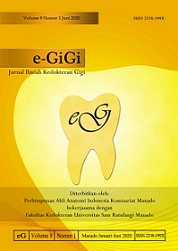Accuracy of Tooth Development as an Indicator of Dental Age Estimation for Children in Indonesia
Abstract
Abstract: Dental age estimation methods have been developed in such a way as to fulfill various requirements of medico-legal, law enforcement, and victim identification in mass disasters. This study aimed to evaluate the accuracy of the Willems dental age estimation method for children in Indonesia. The estimated dental age (EDA) was assessed using the Willems method by two examiners. The statistical analysis was carried out using IBM® SPSS® Statistics version 23.0 (IBM, Armonk, New York, USA). The results obtained 92 panoramic radiographs ranging in age from 8 to 14 years from the Departments of Forensic Odontology and Radiology, Universitas Airlangga, Surabaya, Indonesia. The average chronological age (CA) of the subjects in this study was 11.30+1.43 years for boys and 11.65+1.55 years for girls. The overall mean differences between the CA and the EDA for boys and girls were -0.08+0.76 and -0.31+0.97. In this study, the mean age difference was more significant in girls than in boys. The difference in growth spurt timing between boys and girls may explain the difference in dental maturation, as girls begin their pubertal growth spurt about two years earlier than boys. In general, girls' dental development begins and ends earlier than boys'. In conclusion, the dental age estimation method proposed by Willems can be applied to boys, as there is no significant statistical difference. However, when applying this method to girls, a thorough analysis may be required.
Keywords: chronological age; dental age; forensic odontology; human rights; justice
Full Text:
PDFDOI: https://doi.org/10.35790/eg.v10i1.39553
Refbacks
- There are currently no refbacks.

